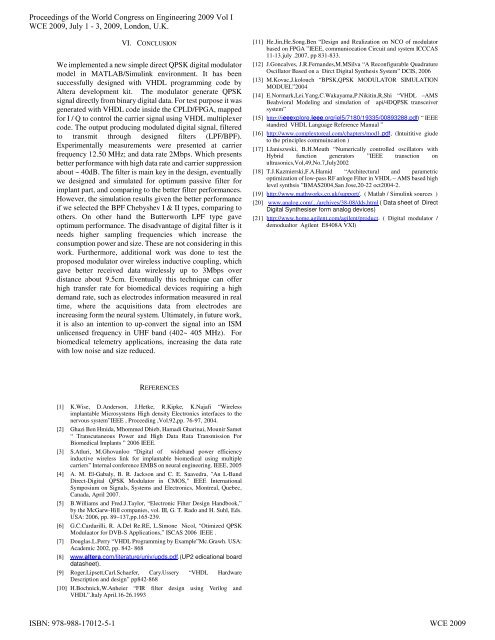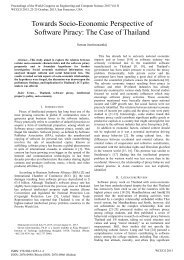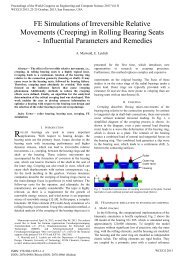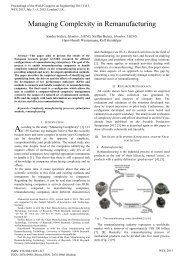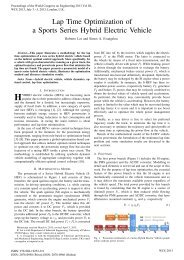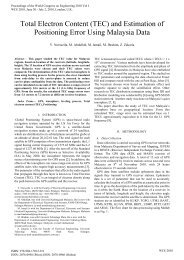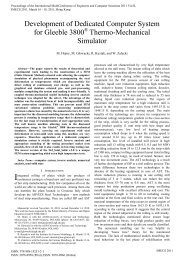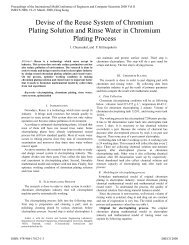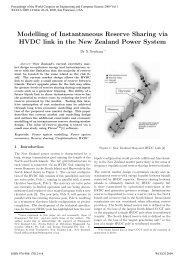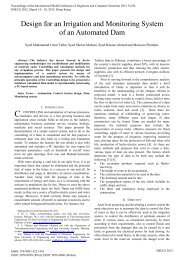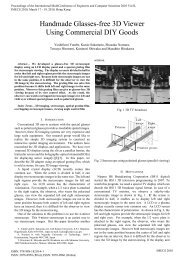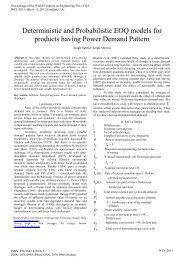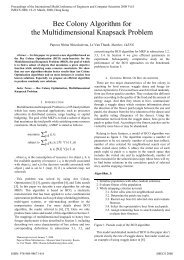A Simple Digital VHDL QPSK Modulator Designed Using CPLD ...
A Simple Digital VHDL QPSK Modulator Designed Using CPLD ...
A Simple Digital VHDL QPSK Modulator Designed Using CPLD ...
Create successful ePaper yourself
Turn your PDF publications into a flip-book with our unique Google optimized e-Paper software.
Proceedings of the World Congress on Engineering 2009 Vol I<br />
WCE 2009, July 1 - 3, 2009, London, U.K.<br />
VI. CONCLUSION<br />
We implemented a new simple direct <strong>QPSK</strong> digital modulator<br />
model in MATLAB/Simulink environment. It has been<br />
successfully designed with <strong>VHDL</strong> programming code by<br />
Altera development kit. The modulator generate <strong>QPSK</strong><br />
signal directly from binary digital data. For test purpose it was<br />
generated with <strong>VHDL</strong> code inside the <strong>CPLD</strong>/FPGA, mapped<br />
for I / Q to control the carrier signal using <strong>VHDL</strong> multiplexer<br />
code. The output producing modulated digital signal, filtered<br />
to transmit through designed filters (LPF/BPF).<br />
Experimentally measurements were presented at carrier<br />
frequency 12.50 MHz; and data rate 2Mbps. Which presents<br />
better performance with high data rate and carrier suppression<br />
about ~ 40dB. The filter is main key in the design, eventually<br />
we designed and simulated for optimum passive filter for<br />
implant part, and comparing to the better filter performances.<br />
However, the simulation results given the better performance<br />
if we selected the BPF Chebyshev I & II types, comparing to<br />
others. On other hand the Butterworth LPF type gave<br />
optimum performance. The disadvantage of digital filter is it<br />
needs higher sampling frequencies which increase the<br />
consumption power and size. These are not considering in this<br />
work. Furthermore, additional work was done to test the<br />
proposed modulator over wireless inductive coupling, which<br />
gave better received data wirelessly up to 3Mbps over<br />
distance about 9.5cm. Eventually this technique can offer<br />
high transfer rate for biomedical devices requiring a high<br />
demand rate, such as electrodes information measured in real<br />
time, where the acquisitions data from electrodes are<br />
increasing form the neural system. Ultimately, in future work,<br />
it is also an intention to up-convert the signal into an ISM<br />
unlicensed frequency in UHF band (402~ 405 MHz). For<br />
biomedical telemetry applications, increasing the data rate<br />
with low noise and size reduced.<br />
REFERENCES<br />
[1] K.Wise, D.Anderson, J.Hetke, R.Kipke, K.Najafi “Wireless<br />
implantable Microsystems High density Electronics interfaces to the<br />
nervous system”IEEE , Proceeding ,Vol.92,pp. 76-97, 2004.<br />
[2] Ghazi Ben Hmida, Mhommed Dhieb, Hamadi Gharinai, Mounir Samet<br />
“ Transcutaneous Power and High Data Rata Transmission For<br />
Biomedical Implants ” 2006 IEEE.<br />
[3] S.Atluri, M.Ghovanloo “<strong>Digital</strong> of wideband power efficiency<br />
inductive wireless link for implantable biomedical using multiple<br />
carriers” Internal conference EMBS on neural engineering. IEEE, 2005<br />
[4] A. M. El-Gabaly, B. R. Jackson and C. E. Saavedra, "An L-Band<br />
Direct-<strong>Digital</strong> <strong>QPSK</strong> <strong>Modulator</strong> in CMOS," IEEE International<br />
Symposium on Signals, Systems and Electronics, Montreal, Quebec,<br />
Canada, April 2007.<br />
[5] B.Williams and Fred.J.Taylor, “Electronic Filter Design Handbook,”<br />
by the McGarw-Hill companies, vol. III, G. T. Rado and H. Suhl, Eds.<br />
USA: 2006, pp. 89–137,pp.165-239.<br />
[6] G.C.Cardarilli, R. A.Del Re.RE, L.Simone Nicol, “Otimized <strong>QPSK</strong><br />
Modulaator for DVB-S Applications,” ISCAS 2006 IEEE .<br />
[7] Douglas.L.Perry “<strong>VHDL</strong> Programming by Example”Mc.Grawh. USA:<br />
Academic 2002, pp. 842- 868<br />
[8] www.altera.com/literature/univ/upds.pdf.(UP2 edicational board<br />
datasheet).<br />
[9] Roger.Lipsett,Carl.Schaefer, Cary.Ussery “<strong>VHDL</strong> Hardware<br />
Description and design” pp842-868<br />
[10] H.Bochnick,W.Anheier “FIR filter design using Verilog and<br />
<strong>VHDL</strong>”.Italy April.16-26.1993<br />
[11] He.Jin,He.Song.Ben “Design and Realization on NCO of modulator<br />
based on FPGA ”IEEE, communiocation Circuit and system ICCCAS<br />
11-13.july .2007, pp 831-833.<br />
[12] J.Goncalves, J.R.Fernandes,M.MSilva “A Reconfigurable Quadrature<br />
Oscillator Based on a Dirct <strong>Digital</strong> Synthesis System” DCIS, 2006<br />
[13] M.Kovac,J.kolouch “BPSK,<strong>QPSK</strong> MODULATOR SIMULATION<br />
MODUEL”2004<br />
[14] E.Normark,Lei.Yang,C.Wakayama,P.Nikitin,R,Shi “<strong>VHDL</strong> –AMS<br />
Beahvioral Modeling and simulation of api/4D<strong>QPSK</strong> transceiver<br />
system”<br />
[15] http://ieeexplore.ieee.org/iel5/7180/19335/00893288.pdf( “ IEEE<br />
standred <strong>VHDL</strong> Language Reference Manual ”<br />
[16] http://www.complextoreal.com/chapters/mod1.pdf, (Intuititive giude<br />
to the principles commuincation )<br />
[17] I.Janiszwski, B.H.Meuth “Numerically controlled oscillators with<br />
Hybrid function generators ”IEEE transction on<br />
ultrasonics,Vol,49,No.7,July2002<br />
[18] T.J.Kazmierski,F.A.Hamid “Architectural and parametric<br />
optimization of low-pass RF anloge Filter in <strong>VHDL</strong> – AMS based high<br />
level synthsis ”BMAS2004,San Jose,20-22 oct2004-2.<br />
[19] http://www.mathworks.co.uk/support/. ( Matlab / Simulink sources )<br />
[20] www.analog.com/.../archives/38-08/dds.html ( Data sheet of Direct<br />
<strong>Digital</strong> Synthesiser form analog devices)<br />
[21] http://www.home.agilent.com/agilent/product. ( <strong>Digital</strong> modulator /<br />
demodualtor Agilent E8408A VXI)<br />
ISBN: 978-988-17012-5-1 WCE 2009


